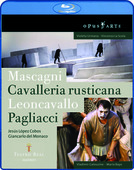Mascagni: Cavalleria Rusticana
Label: OPUS ARTE Catalog: OABD7018D Format: Cavelleria Rusticana deals with two intertwined couples, linked through the amorous yearnings of Turiddu, long in love with Lola, who, upon returning from battle, discovers she has wed someone else. He then takes up with Santuzza, but Lola lures him back with her siren call. Cav is short (one act), and basically a showpiece for Santuzza and Turiddu, with Lola and her cuckolded husband Alfio lending support, along with Turiddu’s mother. The entire piece plays out in “real time,” on Easter Day. This particular staging of Cav is minimalist in the extreme. The set consists of whitewashed rocks that look something akin to Stonehenge after a massive earthquake. All of the cast members are clad entirely in black, giving a stark visual presentation that helps to underscore the bleak emotional terrain that’s being mined. Pagliacci, by contrast, is supposed to be a colorful circus sideshow, which in and of itself runs counterpoint to the roiling emotional undercurrents which provide the opera with its soaring melodies. This particular production doesn’t exactly capitalize on that propensity, clothing some of the fair goers in drab grays and beiges, but it nonetheless has the emotional vibrancy that’s required to bring the strange dichotomy of “on with the show” playing out against “I want you dead.” Pagliacci ups the ante considerably by layering a “show within a show,” which leads to the climactic scene of revenge. All of the leading players in the opera are part of a Commedia dell’Arte troupe, and Leoncavallo brilliantly weaves together the traditional characters of that idiom within the verismo world of Canio, the cuckolded husband of Nedda. By the time the two are onstage together at the end of the play, both the “audience” onstage who is witnessing the proceedings and the “real” audience watching the opera are perhaps confused by what is “art” and what is “real.” In a way, it tips verismo on its head and sees it through a funhouse mirror, albeit perhaps from a house of horrors. Leoncavallo wrote Pagliacci as an actual “answer” to Mascagni’s Cavalleria Rusticana. Therefore it’s no surprise the two fit together so effortlessly. In this particular production, that seam is even more tightly sewn as the dead body of Turiddu is carried through the townsfolk who are proclaiming the coming of the Commedia dell’Arte troupe at the head of Pagliacci’s first act. It’s interesting that neither of these composers really experienced anything similar to the substantial success stories these individual operas wrought for them, and it becomes more interesting that the two seem to be forever linked now in operatic tradition. All of the principals in both of these productions do excellent work. In Cav, Violeta Urmana makes a heartbreaking Santuzza, with a full-bodied voice that reveals her mezzo roots even as she soars stratospherically. Vincenzo La Scola’s Turiddu is a study in duplicity and confusion born of conflicting amorous desires, and La Scola’s beautiful tenor handles Mascagni’s expressive melodies with ease. On the Pag side, the honors obviously go to Vladimir Galouzine as Canio. Following in the footsteps of such famous tenors as Caruso (whose recording of the “pizza” aria—sorry—was one of the first million selling records) and Pavarotti must be a daunting task, but this accomplished Russian doesn’t seem to be too fazed. With a towering upper range, Galouzine pulls every last ounce out of Canio’s torment and ultimate rage. The comedy may be over (to paraphrase Pagliacci’s denouement), but Galouzine seems fated to a long and successful career as one of his generation’s most commanding talents. Though there’s a spareness to director Giancarlo del Monaco’s staging of these venerable pieces, the emotional content more than makes up for it. “Cav and Pag” may be old friends, as it were, but in these compelling interpretations, they feel refreshingly new and vivid. The Blu-ray Video: Sound: Extras: Final Thoughts:  Price: $57.98 Price: $57.98 |












